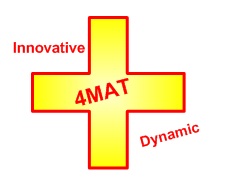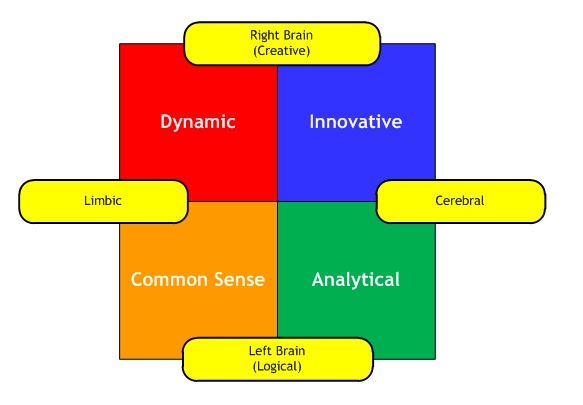4MAT System
The 4MAT System was developed by Bernice McCarthy in 1972. According to McCarthy, there are 4 major learning styles, each of which displays different strengths during the learning process. While all people must engage in all modes of learning, most people seem to favor one particular type.
The 4MAT model is constructed along two continuum’s: perceiving and processing.
Perceiving – the ways people take in new information
Processing – what people do with new information
A person’s individual preference along these continuums determines his or her individual approach to learning.
Types of Learners
Innovative Learners perceive with sensing and feeling and process reflectively. They need to answer the question, “Why?”
Analytic Learners perceive with thinking and process reflectively. They need the facts and to answer the question, “What?”
Common Sense Learners perceive with thinking and process actively. They need to see real-world relevance and answer the question, “How?”
Dynamic Learners perceive with senses and feeling and process actively. They need to answer the question, “If?”
Learners Defined
Innovative/Imaginative Learners: Experiencing (Feeling and Reflecting)
This type of learner enjoys creative and innovative approaches to learning. They perceive information concretely and process it reflectively. They prefer talking about their experiences and feelings, asking questions, and working in groups. They like to have learning connected to real life problems and to be given the answer to “Why do I need to learn this?”.”
Analytic Learners: Conceptualizing (Reflecting and Thinking)
These learners are knowledge-oriented, conceptual, and organized. These individuals perceive information abstractly and process it reflectively. These logical, abstract thinkers want to work with facts, ideas, and details. They prefer to learn by thinking through ideas. They would ask the question: “What do I need to learn?”
Common Sense Learners: Applying (Thinking and Doing)
These learners like active problem solving, learning through discovery, touching, manipulating, constructing, and spatial tasks. They perceive information abstractly and process it actively. They like hands-on experience when learning something new and really want to use what they learn to apply to new situations. The question they ask is; “How do I use the information?”
Dynamic Learners: Creating (Creating and Acting)
These learners prefer to learn through self-discovery and working independently. They enjoy open-ended tasks that involve risk taking. They perceive information concretely and process it actively. They want action; They want to see, hear, touch and feel. They ask the question: “What if?”
Four learning-styles
The four learning-style types from the 4MAT model are Innovative, Analytic, Common Sense, and Dynamic.
Style |
Preference |
| Innovative/Imaginative | Interested in personal meaning and making connections. They prefer to have reasons for learning. Ideally, reasons that connect new information with personal experience and establish that information’s usefulness in daily life.
|
| Analytic | Interested in acquiring facts in order to deepen their understanding of concepts and processes. Prefer to Listen to and think about information, seek facts, and think things through.
|
| Common Sense | interested in how things work; they want to “get in and try it”
|
| Dynamic | Interested in self-directed discovery. Prefer to seek hidden possibilities, explore, learn by trial and error
|
Additional Learning Styles
Felder-Silverman Learning Style
Herrmann’s Brain Dominance HBDI
Left-brain and Right-brain Preferences
Myers-Briggs Type Indicator MBTI




